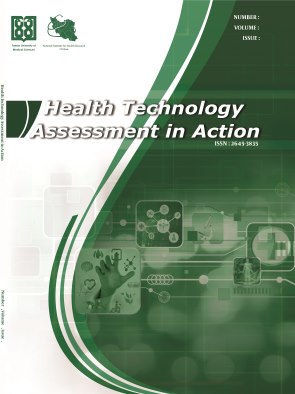Examining the Challenges of Using Accompanying Midwife from the Perspective of Midwives and Pregnant Women Referring to Hospitals in Shahrekord
Abstract
Background: The presence of accompanying midwives (doulas) in the delivery room always entails many challenges. This study was carried out to determine the challenges of attendance with training from the point of view of midwives and expectant mothers in selected hospitals of Chaharmahal and Bakhtiari province, Iran.
Methods: The present study was a descriptive study on 70 midwives working in the delivery block, 120 pregnant mothers, and 20 trained attendants. The sampling of midwives and doulas was performed using the census method, and the sampling of pregnant mothers was conducted using the convenience method. The study tool included questionnaires made by the researcher about demographics and socioeconomics, therapeutics, and psychological challenges for the group of mothers and midwives. The face validity and content validity of the questionnaires were confirmed by midwifery professors and reproductive health specialists, and their reliability was confirmed by internal consistency. The data were analyzed using descriptive statistics with SPSS software (version 21).
Results: In this study, 70 midwives working in selected hospitals of Chaharmahal and Bakhtiari province, 120 pregnant mothers, and 20 trained attendants were examined. Most of the pregnant women (n = 39, 32.5%) mentioned that the most important motivation for requesting a doula during pregnancy and labor was to overcome the fear of childbirth. Most of them (n = 101, 84.9%) also stated that they used doula services at the right time. Meanwhile, 54 women (45%) were familiar with doula services during pregnancy, and most of them (n= 67, 56.3%) stated that doula services can be useful and effective in all three stages of pregnancy, labor, and delivery.
Conclusions: There are dissatisfactions and challenges regarding the support of doulas during pregnancy and childbirth. Therefore, it is recommended to provide the necessary training to healthcare providers, especially obstetricians, midwives, and mothers, regarding the importance and place of doula’s supportive care in this era. Additionally, doula activities should be integrated and promoted in the care of the health team.
2. Rezaie M, Dakhesh S, Parpuchi SF. [Evaluation of the Relationship between the Attendance of a Companion Midwife and Maternal and Neonatal Consequences]. Sci J Nurs Midwifery Param Fac. 2021;6(3):88-96. Persian.
3. Khavandizadhaghdam S. [The Effect of the Continuous Labor Support from a Supportive Companion on the Process and Outcomes of Labor in Primigravida]. J Ardabil Univ Med Sci. 2005;6(4):368-73. Persian.
4. Byrom S, Downe S. ‘She sort of shines’: midwives’ accounts of ‘good’ midwifery and ‘good’ leadership. Midwifery.
2010;26(1):126-37. [PubMed ID:18375025]. https://doi.org/10.1016/j. midw.2008.01.011.
5. Abdella A, Teshome M, Kumbi S. Partureints’ need of continous labor support in labor wards. Ethiop J Health Dev. 2007;21(1):35-9. https://doi.org/10.4314/ejhd.v21i1.10029.
6. Campbell DA, Lake MF, Falk M, Backstrand JR. A randomized control trial of continuous support in labor by a lay doula. J Obstet Gynecol Neonatal Nurs. 2006;35(4):456-64. [PubMed ID:16881989]. https://doi.org/10.1111/j.1552-6909.2006.00067.x.
7. Sarah Beake R, Chang YS, Helen Cheyne R, Spiby H, RM JS, Bick D. Experiences of early labour management from perspectives of women, labour companions and health professionals: A systematic review of qualitative evidence. Midwifery. 2018;57:69-84. [PubMed ID:29223042]. https://doi.org/10.1016/j. midw.2017.11.002.
8. Bohren MA, Hofmeyr GJ, Sakala C, Fukuzawa RK, Cuthbert A. Continuous support for women during childbirth. Cochrane Database Syst Rev. 2017;7(7):CD003766. [PubMed ID:28681500]. [PubMed Central ID:6483123]. https://doi.org/10.1002/14651858. CD003766.pub6.
9. Arnold JA. Social support by doulas during labor and the early postpartum period. Hosp Phys. 2001:57-65.
10. Bogossian FE. Social support: proposing a conceptual model for application to midwifery practice. Women Birth. 2007;20(4):169-73. [PubMed ID:17931991]. https://doi.org/10.1016/j.wombi.2007.08.003.
11. Papagni K, Buckner E. Doula Support and Attitudes of Intrapartum Nurses: A Qualitative Study from the Patient’s Perspective. J Perinat Educ. 2006;15(1):11-8. [PubMed ID:17322940]. [PubMed Central ID:1595283]. https://doi.org/10.1624/105812406X92949.
12. Weindling AM. The confidential enquiry into maternal and child health (CEMACH). Arch Dis Child. 2003;88(12):10347. [PubMed ID:14670760]. [PubMed Central ID:1719387]. https://doi.org/10.1136/adc.88.12.1034.
13. Ballen LE, Fulcher AJ. Nurses and doulas: complementary roles to provide optimal maternity care. J Obstet Gynecol Neonatal Nurs. 2006;35(2):304-11. [PubMed ID:16620259]. https://doi.org/10.1111/j.1552-6909.2006.00041.x.
14. Kozhimannil KB, Vogelsang CA, Hardeman RR, Prasad S. Disrupting the Pathways of Social Determinants of Health: Doula Support during Pregnancy and Childbirth. J Am Board Fam Med. 2016;29(3):308-17. [PubMed ID:27170788]. [PubMed Central ID:5544529]. https://doi.org/10.3122/jabfm.2016.03.150300.
15. Abushaikha L, Massah R. Perceptions of barriers to paternal presence and contribution during childbirth: an exploratory study from Syria. Birth. 2013;40(1):61-6. [PubMed ID:24635426]. https://doi.org/10.1111/birt.12030.
16. Sameei Zadeh Toosi T, Mohammadinia N, Sereshti M. Effect of companionship during labor on level of anxiety of primiparous mothers and midwives points of view in Iranshahr, 2010. J Mazandaran Univ Med Sci. 2013;22(96):41-8.
17. Maputle MS. Support provided by midwives to women during labour in a public hospital, Limpopo Province, South Africa: a participant observation study. BMC Pregnancy Childbirth. 2018;18(1):210. [PubMed ID:29871607]. [PubMed Central ID:5989402]. https://doi.org/10.1186/s12884-018-1860-8.
18. Samieizadeh Toosi T, Sereshti M, Dashipur A, Mohammadinia N, Arzani A. The effect of supportive companionship on Length of labor and desire to breastfeed in primiparous Women. J Urmia Nurs Midwifery Fac. 2011;9(4).
19. Stevens J, Dahlen H, Peters K, Jackson D. Midwives’ and doulas’ perspectives of the role of the doula in Australia: qualitative study. Midwifery. 2011;27(4):509-16. [PubMed ID:20889246]. https://doi.org/10.1016/j.midw.2010.04.002.
20. Neel K, Goldman R, Marte D, Bello G, Nothnagle MB. Hospitalbased maternity care practitioners’ perceptions of doulas. Birth. 2019;46(2):355-61. [PubMed ID:30734958]. https://doi.org/10.1111/birt.12420.
21. Kozhimannil KB, Hardeman RR, Attanasio LB, Blauer-Peterson C, O’Brien M. Doula care, birth outcomes, and costs among Medicaid beneficiaries. Am J Public Health. 2013;103(4):e113-21.[PubMed ID:23409910]. [PubMed Central ID:3617571]. https://doi.org/10.2105/AJPH.2012.301201.
| Files | ||
| Issue | Vol 8 No 1 (2024) | |
| Section | Articles | |
| DOI | https://doi.org/10.18502/htaa.v8i1.15024 | |
| Keywords | ||
| Midwife doula pregnant delivery challenge | ||
| Rights and permissions | |

|
This work is licensed under a Creative Commons Attribution-NonCommercial 4.0 International License. |




